Indoor geranium (or pelargonium) has always been one of the most popular. Very often it can be seen on the windowsills of residential buildings and offices. Pelargonium looks especially attractive at the time of flowering, from spring to autumn, when lush bright inflorescences literally strew the stem. Many believe that geranium is a houseplant, but it turns out that for many centuries it was grown as a picturesque annual in the gardens and parks of Europe and America. This tradition has been gradually returning to us in Russia over the past 20 years. This fact cannot but rejoice: gardeners have at their disposal a very unpretentious flower with a high decorative potential. If you love geraniums and grow them at home, knowing their agrotechnical features will help you prepare them for planting on open soil and provide them with the most comfortable conditions.
Indoor geranium: planting requirements
Pelargonium is considered a hardy plant, but when planting in a garden area, you need to choose a place where it will be exposed to direct light for at least 6-8 hours daily. Geraniums can be transplanted into open ground only after the threat of frost has passed, and the soil has warmed up well. The plant cannot be buried, or, conversely, raised, it must be planted at the same level at which it was in the pot. The soil should be light, loose and well-drained, which is easily achieved by adding leafy compost or peat, the optimum pH for growing geraniums is 6.5 (slightly acidic).
plant care
It is recommended to mulch the soil to retain moisture and prevent overheating during the summer months. Indoor geranium in the absence of rain needs to be watered once a week, it is preferable to water it by sprinkling in the morning, so that the leaves and flowers have time to dry by night. Pelargonium, like all plants, needs to apply liquid organic fertilizers in the active growth phase (every 2-3 weeks), and wilted inflorescences must be removed in a timely manner to maintain constant flowering and maintain attractiveness.
Indoor geranium: preparation for wintering in the house
One of the most important points when keeping any at home is that they should be away from all sources of heat. Temporary isolation is also required to avoid the transition of pests to houseplants. It is necessary to withstand and, if necessary, process the plant. A properly hibernating indoor plant will allow you to restock cuttings for the next garden season.
Indoor geranium: propagation by seeds and cuttings
Pelargonium is easy to grow from seed, allowing the amateur gardener to effortlessly expand their varietal collection. If you want to keep your favorite, then it is very easy to do with the help of cuttings taken from absolutely healthy plants. You need to take a sharp, clean knife and cut off the top or section of the stem with at least one growth point (node), if it is not there, then the plant will not give new shoots. Next, you need to remove the lower leaves, plant the cuttings in well-moistened light soil (preferably a mixture of peat and sand in equal proportions) and keep in good light conditions (but not direct sunlight), you should also not allow the substrate to completely dry out or excessive waterlogging. With proper care, the cuttings take root in 2-3 weeks, then they can be moved to a more lit place and reduce watering to a minimum.
Another way to save your favorite pelargonium until next summer is to simply dig it up with a clod of earth and transplant it into a pot. But this method is not very successful, since the stems gradually stretch and lose their beauty, it is better to rejuvenate the plant with the help of spring cuttings.
So, subject to all conditions, you will be able to grow beautiful, bright and such unexpectedly decorative geranium flowers on the site from year to year.
Mostly in culture, large plants with beautiful foliage and colorful flowers:
Geranium large-rhizome or Balkan
AT natural conditions grows in the meadows of the Balkans, the Alps, the Carpathians. Perennial. It differs from other garden geraniums in its thick, long, 1.5 cm in diameter, rhizome. Due to its rapidly growing rhizome, the plant forms a thicket. Rosettes of leaves extend from the rhizome of this geranium.
Leaves 10 cm wide, oblong-rounded, divided into 7 lobes, coarsely serrated along the edge, brilliant green. Above the thicket of leaves, the stems rise to 10 cm. On the peduncles there are countless reddish or bright purple flowers 3.5 cm in diameter. Geranium blooms in June. Seeds ripen in August.
Geranium large-rhizome is pubescent and fragrant. On a hot day, a thicket of geraniums smells like mountains, the south. Appearance thickets all season is very attractive, sometimes even the leaves overwinter.
As a rule, in November, the foliage of garden geranium acquires a golden or red color. This geranium is used in rockeries, where it grows around stones.
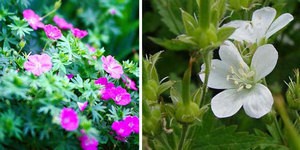
In flower beds, Balkan geranium is planted in the foreground. Here the plant serves as a background for tall plants, for example, such as coreopsis, evening primrose, whitened cornflower, cinquefoil.
Geranium large-rhizome is a long-lived plant. It is a creeping, ground-covering plant. The leaf is deeply dissected, bright green, large, fragrant. Turns red in autumn. Inflorescences from white-pink to carmine. Flowering occurs in June.
Varieties of geranium large-rhizome:
Geranium "Spessagt"- inflorescences are white-pink. It grows rapidly, changes color in autumn, differs in wintering leaves.
Geranium "Ingwersen's Variety"- pink inflorescences
Geranium "Czakor"- purple-red flowers
Geranium "Variegata"- with striped foliage, creamy yellow stripes.
Geranium is magnificent
This type of geranium has been known for over 100 years. On fertile soils and sunny places, magnificent geranium forms a large, rapidly growing bush.
In early July, the plant is covered with countless purple flowers with charming serrated leaves along the edge. In autumn, the foliage turns brick red or orange-yellow.

Lush geranium propagates by dividing the bush. The plant does not form seeds. Large bushes of geranium splendid often fall apart. Use in flower beds or plantings among the lawn.
Himalayan geranium
The plant is native to the subalpine meadows of the Himalayas.
It grows as a small bush, covers the soil with shoots. The foliage of geranium large-flowered is rounded up to 10 cm in diameter. The flowers are large, blue - purple with red veins. There are 3 dark veins visible on the calyx. Inflorescences are large, fragrant, thyroid. Himalayan geranium blooms all summer.
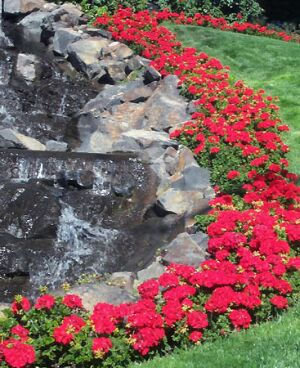
Low growth, beautiful shape, long flowering make Himalayan geranium suitable for use in borders, as well as in rockeries.
In Russia, the Himalayan geranium is little known.
Geranium varieties:
Geranium "Gravetye"- flowers are blue.
Himalayan geranium "Plenum"- terry inflorescences.
Geranium blood red
Homeland is the European part of Russia, the Caucasus, Southern and Western Europe.
It differs from other garden geraniums by the presence of a fleshy, long rhizome, rounded foliage on bristly petioles extends from it. The foliage of blood-red geranium is wintering, green, and in autumn the foliage becomes red in color.

This geranium bush is beautiful. About 60 cm high. The stems almost do not exceed the foliage, and carmine-red flowers strew the entire bush. Flowering of blood-red geraniums is long and abundant.
Blood-red geranium is a perennial that can bloom luxuriantly and even bear fruit without a transplant for 15 years. Optimal growing conditions are neutral soils and partial shade, but it also grows well in open areas.
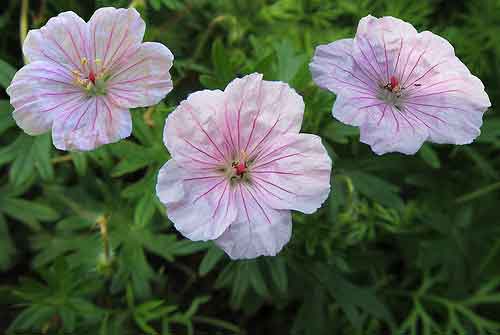
The main feature of this type of geranium is its constant decorative effect. Blood-red geranium bushes are beautiful in spring, summer, and autumn.
Currently, breeders have bred about a dozen varieties of geraniums of this species. Among them:
Geranium "Album"- white, and in autumn they are yellow.
Geranium blood red "Nana"- variety with pink flowers.
Geranium blood red "Prostratum"- low bush with pink flowers.
Geranium blood-red is grown in flower beds. It is used in flower beds, is a decoration of rockeries.
forest geranium
Grows in forests, glades, meadows in Europe, Central Asia, Western Siberia. A plant with long roots. Grows in the form of a bush, can fall apart. The leaves are basal, rounded in outline, coarsely serrated.
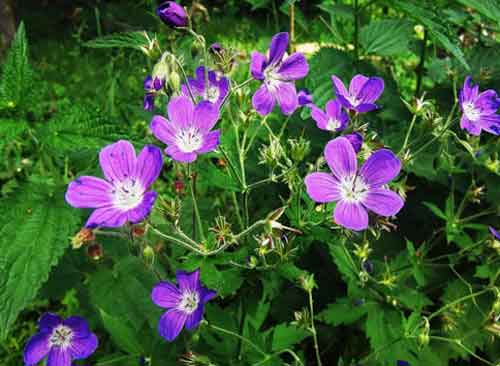
Vegetation ends in August. Forest geranium flowers are numerous, several flowers per peduncle, purple or lilac-purple. Blooms in May. Many varieties of this geranium are cultivated. Among them:
Forest geranium "Album"- flowers are pale pink or pure white.
Forest geranium "Birch Lilac"- purple-blue flowers.
Forest geranium "Mayflower"-bluish flowers with a white center.
Geranium meadow
Grows in meadows, glades, in the forests of Europe and Asia.
Geranium meadow with a short rhizome. The leaves of meadow geranium are numerous, on petioles, hairy. Stems are tall and few. The inflorescence is umbellate.
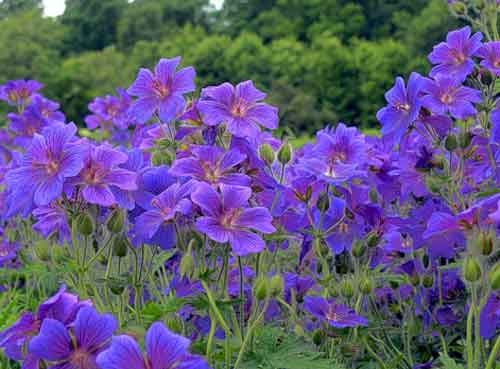
The flowers of meadow geranium are large, lilac-blue. Its petals are rounded. Geranium meadow blooms from June for about 30 days. There are garden forms:
Geranium "Flore Pleno"- semi-double flowers
Geranium meadow "Splish Splash"- variegated blue flowers
Meadow geranium is used in flower beds.
Ash Geranium
Under natural conditions, it grows in Europe, in the Caucasus.
Geranium ash forms a low bush with rounded leaves on petioles.
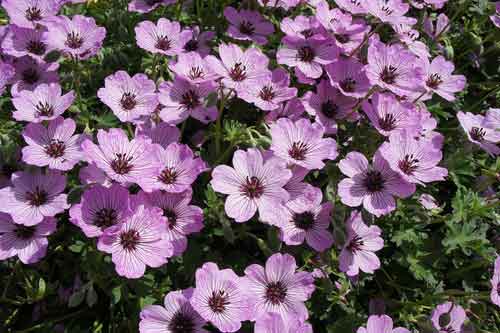
The foliage of the geranium ash has a gray-green color. Stems rise above the foliage, on which lilac-pink flowers grow. Ash geranium blooms in July.
Geranium varieties:
Ash geranium "Ballerina"- grows on rocks, lilac-pink flowers, height 15 cm.
Spring is a great time when flower growers are planting flower beds. Garden geranium is one of the most beautiful ornamental flowering plants, which is loved and revered by many. This flower comes from the southern regions of England, has a unique aroma, healing and decorative properties. Thanks to the work of English and Dutch breeders, new varieties of geraniums have appeared. They simply amaze with their diversity and are readily used in landscape design.
Description of frost-resistant types of geraniums
Geranium garden - decorative leafy perennial with beautiful and delicate flowers. Currently, there are over 290 varieties of this flower, among which there are perennial and annual species. This plant, which requires minimal care, is very popular in many countries.
Garden geranium flowers have the most diverse color - all shades, except for yellow and orange. Although breeders are currently working on the issue of breeding these species. The size of the flowers varies from 3 to 6 cm in diameter, depending on the variety. The decorativeness of this plant is preserved until the frost.
The following varieties are considered the most common.
blood red geranium
 In the wild, this flower can be found on the mountain slopes of the Caucasus and Europe. This is a perennial plant with a compact crown about 60 cm high with dark green leaves. This species blooms with pink flowers in early summer. On the basis of this variety, many hybrid forms have been developed that differ in color and growth - Max Frey, Nanum, Prostranum, Album.
In the wild, this flower can be found on the mountain slopes of the Caucasus and Europe. This is a perennial plant with a compact crown about 60 cm high with dark green leaves. This species blooms with pink flowers in early summer. On the basis of this variety, many hybrid forms have been developed that differ in color and growth - Max Frey, Nanum, Prostranum, Album.
Large-rhizome or Balkan geranium
 This is a perennial, rapidly growing shrub that forms dense curtains - up to 1 m in width. The height of the plant is about 50 cm. In nature, this flower grows at the foot of the Carpathians and the Alps.
This is a perennial, rapidly growing shrub that forms dense curtains - up to 1 m in width. The height of the plant is about 50 cm. In nature, this flower grows at the foot of the Carpathians and the Alps.
The flowering period falls at the beginning of summer and lasts about a month. Intense pink flowers. At good care you can achieve re-flowering in early autumn.
This is an excellent groundcover that does not require special care and can grow in one place for many years.
The following hybrids are especially decorative - Whiteness, Tsakor, Balkanum and Bevans Variety.
Less common types of geraniums

Caring for these flowers is almost the same and does not require special skills and knowledge.
Geranium garden is also represented by a variety of hybrid terry species resembling roses, and simple varieties similar to wild flowers.
Features of growing geraniums in the garden
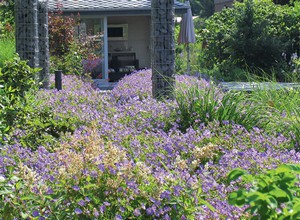 Growing geraniums begins with choosing a planting site, while taking into account the requirements of a particular variety. Some species like to grow in full sun, while others can thrive in partial shade. In a sunny area, you can plant meadow, magnificent and Himalayan geraniums. These species will also feel great in a shady place with a high level of humidity. In arid sunny areas, you can plant the following varieties of geraniums - red-brown, Georgian and large-flowered. Balkan and red-brown geranium grows well in the shade on dry soil.
Growing geraniums begins with choosing a planting site, while taking into account the requirements of a particular variety. Some species like to grow in full sun, while others can thrive in partial shade. In a sunny area, you can plant meadow, magnificent and Himalayan geraniums. These species will also feel great in a shady place with a high level of humidity. In arid sunny areas, you can plant the following varieties of geraniums - red-brown, Georgian and large-flowered. Balkan and red-brown geranium grows well in the shade on dry soil.
To grow beautiful bushes with lush and bright flowering, it is important to purchase high-quality planting material. It can be bought at any garden store or ordered online.
Planting in the garden
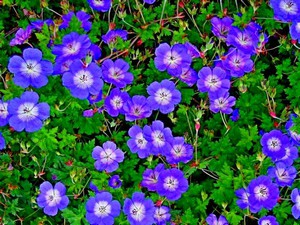 If you are planning to grow geraniums through a rhizome, then it is recommended to buy planting material as early as February. The underground part of the plant should be dense, have adventitious roots and a hard, not dried up growth point. The purchased rhizome is lowered into a container with moistened peat and placed in a refrigerator for storage. The optimum temperature of the content is 1-2 degrees Celsius. So that the planting material does not dry out, it is regularly moistened - once every two weeks. Transplanting the rhizome to the site is carried out only after the earth warms up well.
If you are planning to grow geraniums through a rhizome, then it is recommended to buy planting material as early as February. The underground part of the plant should be dense, have adventitious roots and a hard, not dried up growth point. The purchased rhizome is lowered into a container with moistened peat and placed in a refrigerator for storage. The optimum temperature of the content is 1-2 degrees Celsius. So that the planting material does not dry out, it is regularly moistened - once every two weeks. Transplanting the rhizome to the site is carried out only after the earth warms up well.
Purchased plants that have already begun the growing season should be immediately planted in any planting container a little over size rhizomes. When planting, the long roots of the plant should not be bent.
Mid-May is the period when geraniums are planted in a flower garden. Even with the slightest frost, young plants will need shelter. Non-woven material - agrofiber or lutrasil - is suitable as this.
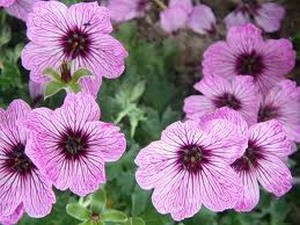 Some flower growers, in order not to bother, buy ready-made plants grown in pots. As soon as warm weather stabilizes, they are planted in a permanent habitat. True, the assortment of potted flowers is not very diverse. And the cost of an open rhizome of a garden geranium is much lower than the price of grown plants.
Some flower growers, in order not to bother, buy ready-made plants grown in pots. As soon as warm weather stabilizes, they are planted in a permanent habitat. True, the assortment of potted flowers is not very diverse. And the cost of an open rhizome of a garden geranium is much lower than the price of grown plants.
Proper planting of a flower is the key to its full growth and abundant flowering. This is a plant with a long root system, therefore, for its planting, a not very wide, but deep planting hole will be required. Its depth depends on the length of the root system of the planted plant. The planting hole is made 15 cm deeper than the longest geranium root.
Planting bushes is carried out at a distance of 30 cm from each other. This distance will be quite enough for the root system of the bushes to fully develop.
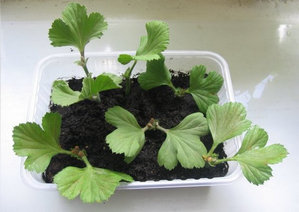 First, the pit is filled with a nutrient mixture, the roots of the plant are carefully laid out on top of it, then covered with soil and watered.
First, the pit is filled with a nutrient mixture, the roots of the plant are carefully laid out on top of it, then covered with soil and watered.
Garden geranium transplantation is carried out in early spring or autumn. During this period, the process of its reproduction is carried out. The bushes are divided into parts so that each division has several roots and at least one growth point. Transplantation of bushes is carried out according to the same principle as their planting.
Almost all varieties of geraniums have the ability to grow actively and quickly. Therefore, you should monitor this process, avoiding the formation of excessive growth. If necessary, in adult specimens, a part of the rhizome is removed.
It is worth remembering that garden geranium does not tolerate the transplant procedure well, therefore, when planting this plant in a flower garden, one should determine its permanent habitat for many years.
Growing in flowerpots
Planting is carried out in pots with drainage holes. The planted plant is well compacted and watered abundantly. During this period, he will need special care - good lighting and coolness. Therefore, it is placed on a glazed balcony or loggia. The soil substrate should always be slightly moist, but not flooded. An excess of moisture can lead to rotting of the root system of the plant.
How to care for geraniums?
 The basic care for garden geraniums is as follows:
The basic care for garden geraniums is as follows:
- This plant is not demanding on soil fertility. It is important that the earth is light, air and moisture permeable.
- Watering. The first time after planting, this plant needs frequent and plentiful watering. In the future, the frequency of irrigation is reduced. Only in summer, on hot days and during the dry season, shrubs need to be watered regularly and often. The lack of moisture will warn drooping leaves of plants.
- Garden geranium does not need to be fed, especially if it grows on fertile soil. But if you decide to feed this plant, then complex mineral fertilizers are the best option in this case. Mountain and tuberous varieties of geraniums are less demanding on fertilizers. Therefore, they are fed with fertilizers of low concentration.
- Basic plant care includes the timely procedure for removing faded buds to allow new ones to bloom.
- Ground cover flowers can be planted next to this plant, then there will be no need for loosening and mulching the soil.
- The main care for this flower includes the reproduction procedure. There are two ways to propagate garden geraniums - by seeds and by dividing the rhizome.
- The procedure for dividing the bush is carried out during plant transplantation, as described above.
reproduction
cultivation ornamental shrub using seeds is a laborious and not always effective process. Using the seed method, the probability of obtaining new plants with all the qualities and characteristics of the main variety is zero. Yes, and to collect fresh planting material is quite problematic. When ripe, the seed pods crack, and the seeds are sown throughout the site. The first flowering in plants obtained from seeds will be the next year after planting.
Other care work and disease prevention
 Some species require leaf pruning. This procedure is carried out in the fall, when the plant has completely faded.
Some species require leaf pruning. This procedure is carried out in the fall, when the plant has completely faded.
Garden geraniums do not require shelter, as they are winter-hardy plants that can easily tolerate a drop in temperature in winter.
One of the main advantages of this flower is its high resistance to diseases and the invasion of harmful insects. This plant rarely gets sick. Essential oils and phytoncides secreted by shrubs create a protective barrier for it.
At high level humidity and insufficient lighting, this plant can be affected by powdery mildew. Treatment of infected specimens is carried out with the help of the drug - Bordeaux mixture. Illiterate care, namely, frequent waterlogging of the soil, provokes the appearance of gray rot. Damaged shrubs are almost impossible to save, so they are immediately removed from the site. When brown spot appears, the plants are treated with a fungicidal solution.
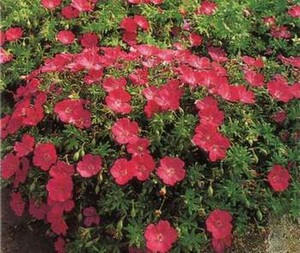 That's all the care that this flower needs in the garden.
That's all the care that this flower needs in the garden.
Garden geranium is an amazing colorful plant that has a place in any garden. Low-growing and dwarf varieties are used with great success for decorating rock gardens, borders, borders and mixborders.
Forest geranium goes well with perennial shrubs and shade tolerant plants.
Tall species are suitable for creating group compositions in combination with other perennials and unpretentious ground cover flowers.
Garden geranium is a versatile solution for your garden. Competent care, planting and optimal conditions of detention are all that this perennial needs for full growth and lush flowering.
In the view of most inhabitants, the plant, although beautiful, is exclusively indoor. Few people know that garden geranium, unlike its room relative, grows very well in open field. Moreover, there are more than three hundred varieties of this plant in the world. England is considered the birthplace of garden geraniums, where it is very popular. Of course, the Russian climate is somewhat different from the British one, but there are varieties of garden geraniums that feel good in our open spaces.
Garden geranium - care and cultivation
How to grow geraniums in the garden? Our tips will help you with this:
- Perennial garden geranium is a very unpretentious plant in planting and care. The soil for garden geraniums needs loose and fertile, and it is better to plant it in open, well-lit areas.
- When marking out a site for planting, it should be remembered that due to short rhizomes, geranium grows very strongly in breadth. Therefore, the distance between the bushes should be at least 25-30 cm. In a year, the geranium bushes will grow so much that they form a continuous carpet. In addition, garden geraniums really do not like to transplant, and large distances between bushes will allow it to grow in one place for a long time without transplanting.
- Garden geranium can grow in one place without transplantation and rejuvenation for 10 years.
- Weeding the area planted with geraniums is not necessary, because its densely growing lower leaves will not allow any weed to grow. If you plant row-spacings with low garden crops or them, then you won’t have to loosen the soil. Thus, caring for geraniums in the garden comes down to timely watering.
- Garden geranium is practically not affected by diseases, and its sharp aroma repels insect pests.
- Perennial garden geranium does not require shelter for the winter and tolerates frost well in open ground.
Propagation of garden geraniums
There are several ways to propagate garden geraniums: rhizome segments or seeds. Propagation of garden geraniums by seeds is a very troublesome task. Firstly, after ripening, the seeds scatter in different directions and it is problematic to collect them. Secondly, with this method of reproduction, varietal characteristics are very often lost. Therefore, most often, garden geraniums are propagated by segments of rhizomes. To do this, in early spring, healthy young rhizomes are selected, which are separated from the mother bush, and then planted in the soil and watered.
Garden geranium - varieties
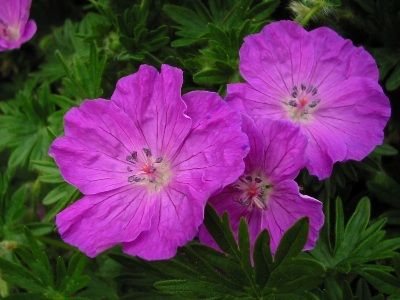
A hundred years ago, the modern favorite of flower growers - garden geraniums - was grown solely because of the unique flavor and medicinal properties . Original, decorative and diverse varieties arose only thanks to English and Dutch flower breeders who turned nondescript meadow and mountain plants into decoration of our gardens.
Geranium meadow is still a raw material for the pharmaceutical industry.
This perennial plant has spread thanks to:
- drought resistance;
- attractive flowering until the first frost (some varieties bloom twice a year);
- high vitality;
- resistance to insects and infections: a specific aroma with phytoncides repels pests and infections.
In the process of growth, perennial garden geranium forms a lush bush of openwork leaves - the leaves are stacked so tightly that the weeds under them do not break through.
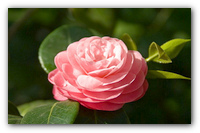
Weeds have no chance to break through dense foliage.
Choose a variety - there are many options
Geranium varieties- It's a variety of colors. AT color scheme so far only yellow and orange colors are missing, but breeders are working in this direction. Medium-sized flowers are formed on the bush - 2.5-4.5 cm.

Geranium magnificent does not form seeds.
The types of geraniums differ not only in the size and color of the flowers, but also in the height of the bush and even in the requirements for care:
- Lugovaya- is a dense shrub up to 120 cm tall. Purple-blue flowers appear in mid-summer.
- Balkan- with a long powerful rhizome. Forms real thickets, as well as purple, reddish 3 cm flowers. The height of the bush is about 30 cm. It blooms in June, for about 30 days.
- Bolotnaya- with purple flowers (2-3 cm), straight and branched stems 50-70 cm in height. The bush is formed compact and dense, blooms in summer. In August, the seeds ripen and self-seeding can occur.
- Gorgeous- fast growing bush up to 50 cm in height. At the beginning of flowering, the flowers are light, purple, and in the fall they become a brick shade. This species is sterile, that is, without seeds.
- Large-flowered (Himalayan)- bush height 30-50 cm, rounded leaves up to 10 cm, large 5 cm purple flowers with reddish veins.
- Georgian- unpretentious and viable plant, blooming profusely purple flowers. In one place it grows up to 12 years, without requiring divisions.
- Red-brown, stably decorative - bizarrely shaped gray leaves, dark purple flowers that adorn the bush for 45 days.
- Pyrenean- characterized by rapid growth and aggressiveness to neighboring plantings. Forms a dense 30 cm bush and small pink-lilac flowers.
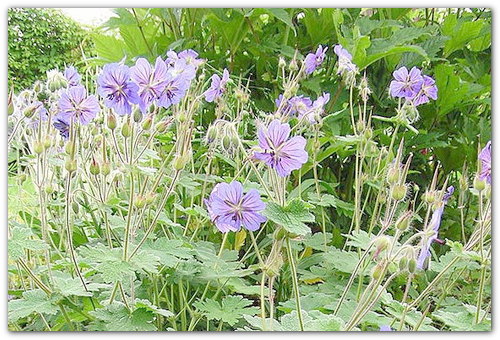
Georgian is very unpretentious and resilient.
Known in garden culture terry reminiscent of roses and simple varieties, more like wildflowers.

Himalayan geranium can reach a height of 30-50 cm.
When choosing a place to plant a bush, you need to consider a specific type:
- for sunny and humid places: Himalayan, meadow and magnificent;
- in partial shade and high humidity: Himalayan, meadow, swamp;
- sunny and dry red-brown, large-flowered, Georgian;
- shade and dry soils: red-brown, Balkan.

The type is selected depending on the lighting and type of soil.
What you need to know about planting material
Purchase planting material at the nearest garden center (in the online store, in the market) back in february- if you plan to grow geraniums from rhizomes. good rhizome must be firm, with many adventitious roots. The growing point should not be dry or soft.
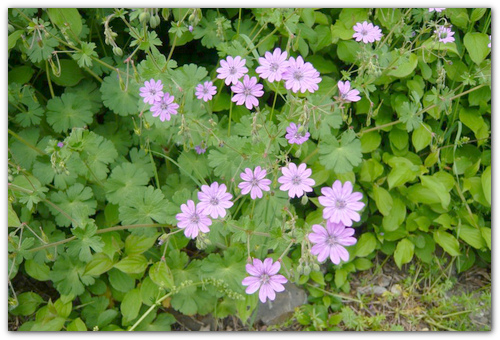
The Pyrenean differs from other species in the shape of the petals.
The selected rhizome is placed in slightly moistened peat, and then in the refrigerator (the plant is stored at a temperature of +1-+2°C). Peat is moistened every 2 weeks until the earth warms up in the garden, after which the plant needs to be planted.
Important! The ashy geranium variety is acquired only in a dormant state (with an open root system) - it is poorly stored, quickly starting to grow.
If you purchased a perennial plant already in the growing season- thin roots and rudiments of leaves - then it must be temporarily planted in a container. The dimensions of the container should correspond to the size of the roots - so that even long roots fit in it without bending. Drainage holes are needed in the tank - they can be made both from below and from the sides. The plant is planted, compacted and watered, and then placed in a bright but cool place (for example, on a glazed loggia). The substrate is kept moist - waterlogging will lead to root rot. In May, geraniums are planted in the garden, but during frosts they are covered with non-woven material.

Geraniums planted in the garden are covered with non-woven material when there is a threat of frost.
A good option would be purchase of grown geraniums in pots. They can be immediately planted in a permanent place, or they can be kept until planting in the shade, watering in a timely manner. However, the range of plants in containers is not so great, and the price of plants with an open root system is lower.
Unique Japanese, as a rule, causes universal admiration of those who see it. In Japan, she is considered the standard of good taste and entire gardens are dedicated to her!
The chrysanthemum is also highly respected in eastern countries. decorates gardens and parks in the most inclement autumn weather.
Planting and transplanting geraniums according to the rules
You are guaranteed success in cultivation, if you plant the plant correctly- for most varieties, a well-lit area is preferable. Keep in mind that the plant usually has long roots, and therefore the planting hole should not be wide, but deep - 20 cm deeper than the longest root. Leave 25-30 cm between the bushes - this will allow the roots of the plant to develop in breadth.
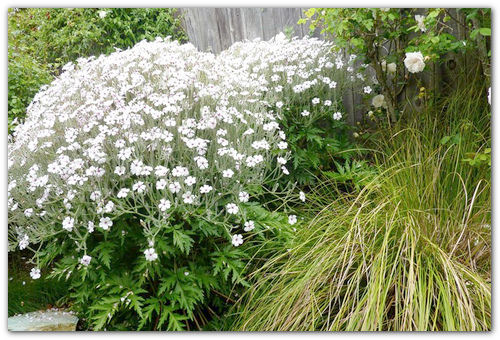
Inside the pit, a cone is poured fertile soil, on top of which the roots are laid out. Then we fill everything with high-quality soil and water it. Please note that unripe manure is contraindicated- there are no more special requirements for planting garden geraniums.

Balkan large-rhizome: no one can do without it country cottage area In Bulgaria.
This perennial plant is transplanted in autumn or spring.. In the process of transplantation, overgrown bushes are also divided. The transplanted geranium is transplanted and watered abundantly. Make sure that the bush does not grow excessively, occupying territories not intended for it. This may even require the removal of part of the rhizome.
Geranium does not tolerate transplants, so immediately choose a place for it in a flower bed, taking into account the growth of the plant and its height in adulthood.
We propagate - 2 possible ways
Reproduction of perennial geraniums is possible in 2 ways:
- seed- time-consuming and does not always allow you to save varietal characteristics. Some varieties of geraniums do not form seeds at all, and some reproduce by self-sowing without any human intervention. It is not easy to collect the seeds - the boxes burst and the seeds scatter through the air. If you still decide to experiment, then use fresh seeds. Keep in mind that plants will bloom only next year.
- Vegetative- separate part of the bush (it is best to do this in the spring) and transplant it into previously prepared soil. Compost and peat fertilizer are added to the soil. Also provide abundant watering after transplantation. A month after planting, they are fed for the first time.
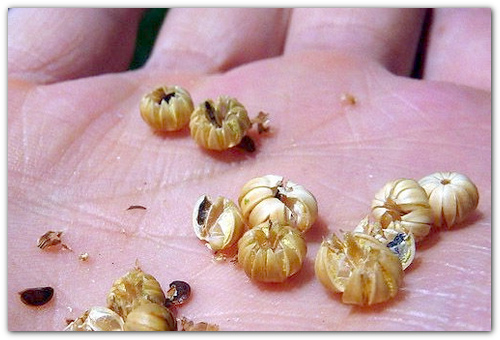
Seed propagation does not always allow preserving varietal characteristics.
To your garden plot decorated this flower for a long time, ensure the proper care of the garden Geranium:
- The most important - timely watering.
- Plant will not require transplantation and rejuvenation for 10 years. Almost immediately, it will grow so much that it will eliminate all the weeds by itself.
- To you you don't even have to loosen the soil- plant low-growing crops between geranium bushes or mulch the soil immediately after planting.
- In autumn, after the geranium has faded, you can trim the leaves. But most of these plants winter green, which means they hibernate without pruning.
- Shelter for the winter is not provided- the plant tolerates sub-zero temperatures in open ground.
Important! Do not work with geraniums in the heat - its leaves emit a lot of essential oil, which will provoke skin itching.
How to keep a plant healthy
garden geranium responds well to fertilization. Most varieties wake up early - in the spring they need to be fed with nitrogen fertilizer, and after a month - with any complex fertilizer. Keep in mind that mountain and tuberous geraniums do not need fertilizers so much - they reduce the amount of feeding for them.
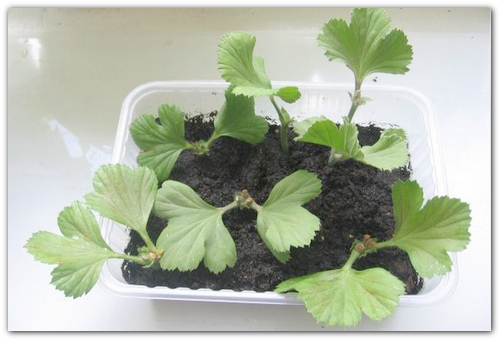
Vegetative propagation is the most reliable way.
Pungent leaf scent(due to saturation with essential oils) repels insect pests from geraniums, and the plant is almost never affected by diseases. Diseases can manifest themselves in cold and wet conditions:
- with powdery mildew diseased parts of the plant are removed, and the rest is treated with a Bordeaux mixture;
- gray rot indicates waterlogging of the soil - the affected plant can rarely be saved;
- brown spot removed by fungicide treatment.
![]()
Red-brown - the most decorative.
In dry and hot conditions, geraniums can settle spider mite- it is eliminated with an insecticide or a soapy solution.
The beautiful geranium is one-stop solution for your garden. In the variety of varieties you will find ground cover and upright tall plants. They will be appropriate in rockeries, mixed flower beds, group plantings and mixborders.

The swamp variety has almost creeping branches.
Video
A variety of varieties of garden geraniums from the private collection of an amateur gardener.




















